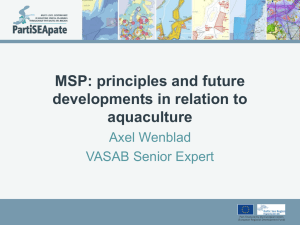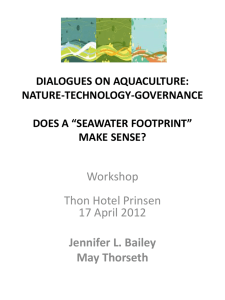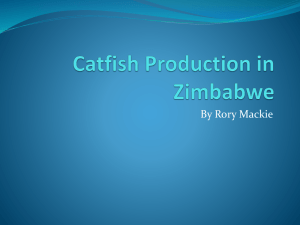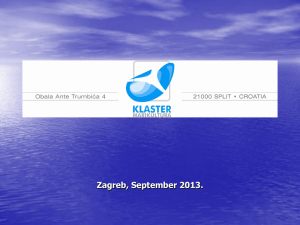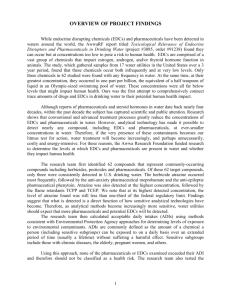Impact on Socio
advertisement
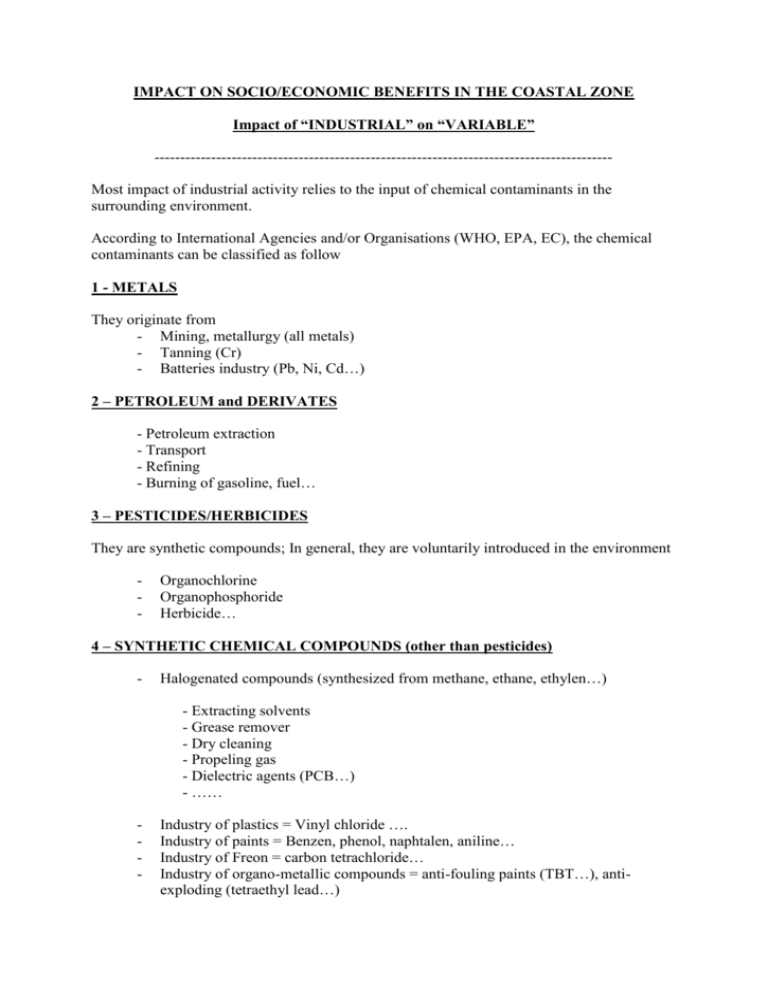
IMPACT ON SOCIO/ECONOMIC BENEFITS IN THE COASTAL ZONE Impact of “INDUSTRIAL” on “VARIABLE” ----------------------------------------------------------------------------------------Most impact of industrial activity relies to the input of chemical contaminants in the surrounding environment. According to International Agencies and/or Organisations (WHO, EPA, EC), the chemical contaminants can be classified as follow 1 - METALS They originate from - Mining, metallurgy (all metals) - Tanning (Cr) - Batteries industry (Pb, Ni, Cd…) 2 – PETROLEUM and DERIVATES - Petroleum extraction - Transport - Refining - Burning of gasoline, fuel… 3 – PESTICIDES/HERBICIDES They are synthetic compounds; In general, they are voluntarily introduced in the environment - Organochlorine Organophosphoride Herbicide… 4 – SYNTHETIC CHEMICAL COMPOUNDS (other than pesticides) - Halogenated compounds (synthesized from methane, ethane, ethylen…) - Extracting solvents - Grease remover - Dry cleaning - Propeling gas - Dielectric agents (PCB…) - …… - Industry of plastics = Vinyl chloride …. Industry of paints = Benzen, phenol, naphtalen, aniline… Industry of Freon = carbon tetrachloride… Industry of organo-metallic compounds = anti-fouling paints (TBT…), antiexploding (tetraethyl lead…) Furthermore, to this list of industries, we can add several industries such as - The industry of radio-elements (power plan…) - The industry of wood (deforestation…) leading to a huge input of mineral particles in the water bodies, from the watersheds - The food and /or paper industry leading to inputs of organic matter COMMENTS ON THE TABLE Industrial vs Algal toxins No “level influence” has been given to this parametre. Perhaps we can consider that it can be an impact of “metal” industry on it if we consider that some metal (such as Fe) may have an influence on the growth and on the structuration of the phytoplanktonic population (see Industrial vs phytoplankton abundance/diversity). Level 3 could be given to this parametre Industrial vs Artificial radionuclide Artificial radionuclide constitutes a typical example of the reflection which can be done to attribuate a “influence level” to the studied parameters thus, 1 – In Europe, except for accidental contamination (Tchernobil for exemple), the quantity of artificial nuclide released in the environment is “ 0”! 2 – Nevertheless, though the quantities released are very low, industry is the main producer of artificial radio nuclides 3 – So far, there is (apparently) no reference concerning, in Europe, a problem related to the impact of nuclides on aquaculture products! If we try to determine the level of impact: 1 - The fact that Industry is the main producer? In that case, the level is 1. 2 – The fact that there are very, very low quantities released in the environment? The level should be 3! 3 – The fact that, up to now, no problem occurred in aquaculture, fishing… regarding the radionuclide… The level should be 3? 4 – The fact that accidental spill can lead to the release of huge quantities of nuclides, which can be considered as potential huge problem for aquaculture, fisheries, tourism activities…? The level should be 1. “Level 1” is given and justified if we consider that industry is the main supplier of radionuclides to the environment. If we consider that Artificial radionuclide does not constitute an important problem either for the marine environment sensu largo or for aquaculture more specifically, one can consider that “level 3” can be affected to this parametre Industrial vs Dissolved oxygen In fact, the main problem concerning the relationship between industry and dissolved oxygen comes from the industry releasing organic matter in the environment (food, wood, paper industries). We can also consider that industries of metals may have a localised impact on dissolved oxygen through the oxidation of non-oxidized salt to oxydized salt (Ferrous iron ferric iron, for exemple). “Level 1” is given, because industry is not the main supplier of “oxygen consumer (see “municipal wastes”, food industry…), the level should be 2 or 3. Industrial vs herbicides/pesticides/biocides These compounds are, in general of synthetic nature. They are voluntarily introduced in the environment. Concerning aquaculture, the main problem is related, in some developing countries, to the “cohabitation” of organism (shrimp, fish…) rearing, and the intensive use of herbicides and pesticides in the watershed upstream the rearing ponds. Level is 3. This seems justified, the main supplier to the environment being agriculture and agro-forestry Industrial vs litter/plastics Industry is, like for pesticides and herbicides, the main producer… but industry is not the main “supplier to the environment”. For litter and plastics, the dumping of litter and plastics constitutes one of the main spectacular, because visible, aspect of the pollution of the shore. The main supplier to the environment is related to the use of plastic bags, plastic bottles at domestic level, not at industrial level… The main socio-economic impact concerns mainly the tourism (see “Tourism vs litter/plastics”). Level is 1, it could be 2 or 3. Industrial vs Metal and organo-metals Metal and organo-metals constitute the most studied category of contaminants in the warine environment. These contaminants have been, so far, the most involved in the most important problems related to human health and to economic impacts. We may refer to the Minamata case for mercury, the TBT (Tributhyltin) which affected the growth of oysters and the spat catching in the Bassin d’Arcachon, or the concentration of cadmium in oysters from Gironde estuary, du to mining activities in the upper part of the watershed. In that last xase, the problem does not concern the vital functions of the oysters (growth and reproduction), but the fact that the concentrations observed in the organismes exceed the maximum concentrations allowed by the European rules. Hence, oysters are unsuitable for commercialisation. It is to be noted that, to our knowledge, only 3 metals (Cd, Pb, Hg), among the totality of contaminants have been subject to a European regulation concerning the maximum allowable concentrations in fisheries and aquaculture products. Level is 1. It sounds correct Industrial vs Nutrients Nutrients such as NO2-3, NH3-4, Phosphate are mainly issued from agro-industry (see “agroforestry vs nutrients”). Level is 3. Correct! Industrial vs PAHs and Industrial vs Petroleum hydrocarbon/oil. The main sources of PAHs in the environment are the oil/gaz extraction/production (see “PAHs vs oil/gaz extraction/production”). Because industries use gaz and oil as energy, we may consider that they contribute, for a minor part, to the release of these compounds in the surrounding environment. Level is 2. Correct! Industrial vs Phytoplankton abundance/diversity Phytoplankton abundance/diversity are mainly under the dependence of nutrients concentrations and equilibrium. Nevertheless, one may consider that industrial effluents can play a role on such parameters. Thus it has been shown the influence of heavy metals, such as Fe (concentrations and speciation) on the growth and on the structure of phytoplanktonic populations Level is 3. Correct! Industrial vs pharmaceuticals Pharmaceuticals industry is the main producer of pharmaceuticals but it is not the main direct “supplier” to the environment. No huge problems have been related concerning the impact of pharmaceuticals on the environment. Antibiotics used in aquaculture (see “aquaculture vs pharmaceuticals”) are not taken into account in this paragraph. Level is 2. Correct! Industrial vs Suspended Particulate matter Industy is far to be one of the main supplier of particules. The main “suppliers” of SPM to marine environment are the agroforestry (deforestation), the mining activities and the public works (road construction….). Food Industries release particulate organic matter… Level is 2. It could be 3! Industrial vs Synthetic organics/POPs Industry is the only producer of synthetics compounds (see the different categories above). From that point of view, one may consider that industrial activities is the main “provider” of synthetics compounds to the environnement. Level is 1. Correct




